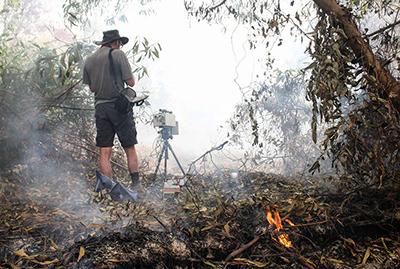When we picture a wildfire, it’s unlikely we would imagine a smoldering peat fire. These fires burn for days or weeks under the top layer of soil, releasing smoke and heat through the soil and vegetation. Although they may not seem threatening, tropical peat fires release gases into the atmosphere that contribute to pollution, human respiratory problems, and climate change.
These ecosystems are carbon sinks that trap potentially harmful greenhouse gases, and peatlands in tropical countries like Indonesia and Malaysia have an outsized role in carbon storage. Although they make up just 10% of global peat ecosystems, tropical peatlands may store more than 30% of the global peatland carbon. But that means when peatlands burn—usually because of agriculture or poor land managment—greenhouse gases make their way into the atmosphere. Estimates indicate that tropical peat fires account for at least 25% of the total greenhouse gas emissions from deforestation.

Most studies of peatland fire emission factors, which help researchers approximate the amount of pollutants released into the atmopshere, have been carried out in a laboratory setting. The Intergovernmental Panel on Climate Change uses such studies to inform their greenhouse gas accounting, but these lab-sourced values may not accurately represent actual emissions from peatland fires.
To help address this problem, Smith et al. calculated peatland emission factors in the field. They used spectroscopy to measure the levels of 12 different gases, including carbon dioxide, carbon monoxide, methane, and ammonia, within the smoke plumes of 10 peat fires in Malaysia. They also took core samples at each site to measure the depth of the burn and analyze the physical and chemical makeup of the peat fueling the fire, as well as vegetation type, moisture content, and bulk density of the peat.
The researchers found that the physical properties of the burn sites affect the amount of greenhouse gases that wind up in the atmosphere. In particular, they suggest that the bulk density of the peat—or the weight of the soil in a given volume—influences the temperature and rate at which the fire spreads. Peat with a higher bulk density burns hotter but spreads more slowly, with less access to oxygen. The researchers found that these effects are linked to increased methane emissions from peat with higher bulk densities.
All of the fires occurred on degraded peat, however, which means their results will likely differ from emission factors studied at pristine peatlands. For example, the peat density at the study sites was 2 to 6 times higher than the density of a pristine peatland. The authors note that degraded peatland will have a higher density because of peat compaction, resulting in more methane emissions during a fire.
The team also concluded that land management can introduce more nitrogen into the peatland, which could end up in the atmosphere once it is combusted.
Further research is needed to see how the lower bulk density found in nondegraded peat ecosystems might affect emission factors. In the meantime, this study offers a new set of values for climate scientists to incorporate into climate change models, which could more accurately predict the effects of greenhouse gases in the atmosphere. (Global Biogeochemical Cycles, https://doi.org/10.1002/2017GB005709, 2018)
—Alexandra Branscombe, Freelance Writer

